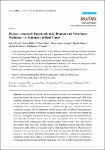Ricinus communis Intoxications in Human and Veterinary Medicine — A Summary of Real Cases
Worbs, Sylvia
Köhler, Kernt
Pauly, Diana
Avondet, Marc-André
Schaer, Martin
Dorner, Martin
Dorner, Brigitte
Accidental and intended Ricinus communis intoxications in humans and animals have been known for centuries but the causative agent remained elusive until 1888 when Stillmark attributed the toxicity to the lectin ricin. Ricinus communis is grown worldwide on an industrial scale for the production of castor oil. As by-product in castor oil production ricin is mass produced above 1 million tons per year. On the basis of its availability, toxicity, ease of preparation and the current lack of medical countermeasures, ricin has gained attention as potential biological warfare agent. The seeds also contain the less toxic, but highly homologous Ricinus communis agglutinin and the alkaloid ricinine, and especially the latter can be used to track intoxications. After oil extraction and detoxification, the defatted press cake is used as organic fertilizer and as low-value feed. In this context there have been sporadic reports from different countries describing animal intoxications after uptake of obviously insufficiently detoxified fertilizer. Observations in Germany over several years, however, have led us to speculate that the detoxification process is not always performed thoroughly and controlled, calling for international regulations which clearly state a ricin threshold in fertilizer. In this review we summarize knowledge on intended and unintended poisoning with ricin or castor seeds both in humans and animals, with a particular emphasis on intoxications due to improperly detoxified castor bean meal and forensic analysis.
No license information

